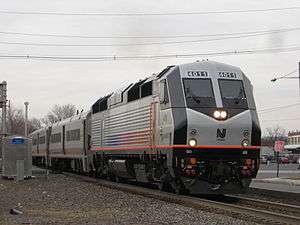Alstom PL42AC
| PL42AC | |||||||||||||||||||||||||||||||
|---|---|---|---|---|---|---|---|---|---|---|---|---|---|---|---|---|---|---|---|---|---|---|---|---|---|---|---|---|---|---|---|
 NJTR PL42AC #4011 | |||||||||||||||||||||||||||||||
| |||||||||||||||||||||||||||||||
| |||||||||||||||||||||||||||||||
| |||||||||||||||||||||||||||||||
| |||||||||||||||||||||||||||||||
| Sources:[1][4] except where noted | |||||||||||||||||||||||||||||||
The Alstom PL42AC is a class of four axle Bo-Bo diesel-electric locomotive designed by Alstom in association with GM-EMD between 2003 and 2006 for New Jersey Transit, USA.
Description
The PL42AC is a diesel-electric 4-axle locomotive built at by Alstom with GM-EMD 710 engines for New Jersey Transit. The first 33 locomotives were manufactured at the Meinfesa plant in Valencia, Spain in 2003.[5] Later units were assembled at the Alstom Transport plant in Hornell, New York in 2004[6] and were produced through early 2006. The power rating of the PL42AC locomotives is 4200 hp (3.1 MW) total for tractive effort and head-end power.
This locomotive uses IGBT technology with precise traction computers for tractive effort. The PL42 has 800 kilowatts head-end power and WABCO's EPIC II braking system, along with an E-7 wheel slide device, made by Wabtec, preventing flats spots on the wheels through software and hardware.
It has an Intelligent Display Unit (IDU) based on Bombardier Transportation technology from which an engineer or technician can view data or download events and faults from the previous weeks or months. The technician can do a host of tests from the IDU to determine if a specific system is operating correctly.
The PL42AC uses computer hardware and software to control functions and to protect the engine. For example, if the on-board computer detects too little oil in the system, it will shut down the engine to avoid damage.
The PL42AC has been described as a "rough rider" by train crews due to severe lateral motion while at high speeds. On the Atlantic City Line, high speeds must be maintained for long distances, so PL42AC locomotives are no longer used on this line.
References
- 1 2 Vantuono, William C. (August 2002), "When form follows function - industrial design (p.2 of 3)", Railway Age
- 1 2 "Mainline Diesel-Electric Locomotives : PL42 AC" (PDF), www.vossloh-espana.com
- ↑ http://i.ebayimg.com/t/New-Jersey-Transit-PL42-AC-Locomotive-Operating-Instruction-Manual-/00/s/MTIwMFgxNjAw/z/gWUAAOxyRhBSujr4/$_12.JPG?rt=nc
- ↑ "New locomotives for NJT", THE TRANSFER TABLE The Wilmington Chapter NRHS Official Newsletter Internet Edition, 24 (7), Sep 2002
- ↑ "Vossloh España Product References". Retrieved 2009-03-23.
- ↑ "After nearly four years of development, design, and construction, New Jersey Transit's 33 PL42AC diesel-electric locomotives have been completed and are expected to begin testing and certification on NJT lines soon", Railway Age, 1 April 2005
External links
- PL- 42 AC Locomotive, Vergarastudio Llc
| Wikimedia Commons has media related to PL42AC locomotives. |
